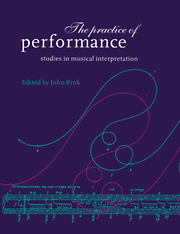Book contents
- Frontmatter
- Contents
- Preface
- PART ONE FUNDAMENTALS
- 1 What do we perform?
- 2 Expression in performance: generativity, perception and semiosis
- 3 Musical motion and performance: theoretical and empirical perspectives
- 4 Deliberate practice and elite musical performance
- PART TWO STRUCTURE AND MEANING IN PERFORMANCE
- PART THREE PERFORMANCE AS PROCESS
- Index
3 - Musical motion and performance: theoretical and empirical perspectives
Published online by Cambridge University Press: 10 October 2009
- Frontmatter
- Contents
- Preface
- PART ONE FUNDAMENTALS
- 1 What do we perform?
- 2 Expression in performance: generativity, perception and semiosis
- 3 Musical motion and performance: theoretical and empirical perspectives
- 4 Deliberate practice and elite musical performance
- PART TWO STRUCTURE AND MEANING IN PERFORMANCE
- PART THREE PERFORMANCE AS PROCESS
- Index
Summary
THEORETICAL ISSUES
Traditional perspectives
Experiences of movement – of its character and expressiveness – are vitally important to composers, performers and listeners alike. This fact is borne out on several levels of discourse. As action plans, musical scores provide general instructions on how instrumentalists and singers may execute, control and coordinate their motor actions, the details of which are determined largely by the performers' musical sensibilities. Undergraduate harmony textbooks, theoretical treatises, analytical essays and historical studies all evoke images of movement presumably associated with the musical experience. ‘Motion speak’ may be as commonplace as the phrase ‘C# moves to D’, or as colourful as David Lewin's description (1982: 53) of a striking moment in Schubert's ‘Auf dem Flusse’, where the singer ‘takes a sharp stone and scratches a G# on the icy surface of the [pianist's] right hand’. Do these expressions point to a genuine perceptual experience of movement or a propensity to speak in metaphor (or both)? If the former, then what is the nature of that experience?
In some form or another, these questions have occupied the minds of theorists and philosophers throughout the centuries, and more recently the minds of psychologists. Collectively, they have given us two basic categories with which to frame our understanding of musical motion: namely, rhythmic motion and tonal motion (the latter often being subdivided into melodic motion and harmonic motion). In the light of these categories, studies of musical motion tend to concentrate on one of four topics: (1) the source of motion; (2) the organisation of motion; (3) the character, or quality, of motion; and (4) the listener's perception and response to motion.
- Type
- Chapter
- Information
- The Practice of PerformanceStudies in Musical Interpretation, pp. 55 - 83Publisher: Cambridge University PressPrint publication year: 1995
- 50
- Cited by



